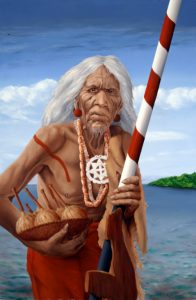History of Melbourne Beach
Early Inhabitants
The first inhabitants of Melbourne Beach were most likely the Ais, or Ays, a tribe of Native Americans who inhabited the Atlantic Coast of Florida in pre-Columbian times. The Ais lived in villages and towns along the shores of the great lagoon called Rio de Ais by the Spanish, and now called the Indian River. [Observations on the appearance, diet and customs of the Ais at the end of the 17th century are found in Jonathan Dickinson’s Journal].
It has been suggested that Juan Ponce de León landed near Melbourne Beach in 1513, where he then became the first European to set foot in Florida. A determination of this was made by a historian in the 1990s, who believed that the spot was “within five to eight nautical miles” on the barrier island with a proposed name of Ponce de León Island. However, this suggestion has not been met with wide acceptance from historians who state that de Leon’s landing place cannot be known within a leeway of less than a hundred miles or so.

Theodore Morris
Vero Beach Central Library
19th Century
In 1883, Major Cyrus Graves, a Union veteran, began buying government land comprising present-day Melbourne Beach for the modest sum of $1.25 an acre. The foundations of the town were first constructed during the winter of 1888-1889. Myrtle Cottage, which stood at the northeast corner of Ocean Avenue and Pine Street, was the first house to be built in Melbourne Beach. In 1892, the Community Chapel was built just west of it. Homes built during the 1890’s and still standing are at 517 and 522 Ocean Avenue, 905 Riverside Drive (then River Road), and 325 Avenue A. The Villa Marine, standing on the corner of Ocean Avenue and Riverside Drive, was built in 1912. Since its construction it has served as a hotel, a frat house in the 1970s, and a Dentist’s office today.
During that same winter, a pier identical to the present day one was built by the Melbourne and Atlantic Railroad Company. With it came the construction of a railroad that ran the length of Ocean Avenue and out onto the pier. On the ocean end of the track stood a bathhouse; it was built where Sand on the Beach now stands. The Melbourne and Atlantic Railroad ran west across Ocean Avenue with just one modest push car. Once the town had become habitable, the initial economic pursuit of its residents was to turn the dense island shrubbery into land suitable for agriculture, with pineapples being the crop of choice. Despite their best efforts to cater to the plant’s specific needs, including importing Australian pines to prevent damage from the cold, the founding families did not find long-term success through agriculture; the freeze of 1894-95 destroyed all of Florida’s pineapple crops.
In 1909, a stock company called the Melbourne Beach Improvement Company, formed by some of the town’s founding fathers including Lawrence Ryckman, Captain Rufus W. Beaujean, and Don R. Beaujean, tasked themselves with rebuilding the pier and railroad, and from then on dealt mainly in real estate. The newly incorporated company also purchased an eight-passenger gasoline powered Buda motor tram, with trailer, to be used on the reconstructed railroad. The company is also credited with constructing the original town hall, which also served as a post office. The building sat facing the river in what is now Ryckman Park. In 1953 when the new town hall building was constructed, the Old Town Hall was floated down the river, and then moved again some time later to where it now sits between Oak Street and Highway A1A.
20th Century to Today
The Town of Melbourne Beach did not experience much population growth during the early 1900s. New homes were constructed in the hopes of attracting renters, but it failed to have any significant impact on tourism. A surge of infrastructure and modernization did not come until after World War I when the toll bridge from Melbourne to Indialantic was constructed. Previously, transportation across the river was provided by Beaujean’s ferry; it would dock on the end of the pier where passengers and supplies could be loaded onto the tram for the journey up Ocean Avenue. The construction of the bridge negated the need for the ferry, and also became the catalyst for the town’s incorporation in 1923. Travel by automobile meant the town needed actual paved roads. The town incorporated in order to get money from bonds to fund the road paving.
At this time an oceanfront business called the Casino was a town focal point. Its main use was as a recreational hall, but it did indeed have slot machines for gambling. Some of its other features include a swimming pool and small concrete cubicles that could be rented out overnight, almost like early-versions of motel rooms. In addition to events at the Casino, there were other recreational activities around town including Sunday school meetings, a public library, Bingo nights, and The Iceman’s Ball. By the time of The Great Depression, the population growth was still relatively stagnant. Through World War II there were still no more than one hundred residents in town.
The real population boost came with the development of our nation’s Rocket Program at Cape Canaveral beginning in the late 1950’s; it brought enormous change to surrounding areas, including population increases and economic prosperity. Our town experienced commerical growth, the creation of a busy two-lane state road that cut straight through town, and the installation of our first stoplight. In spite of all this change, Melbourne Beach was able to preserve much of its past and original charm. Even today, everything one needs is within walking distance, and bicycles are everywhere. There are now over three thousand people who call the town home.

